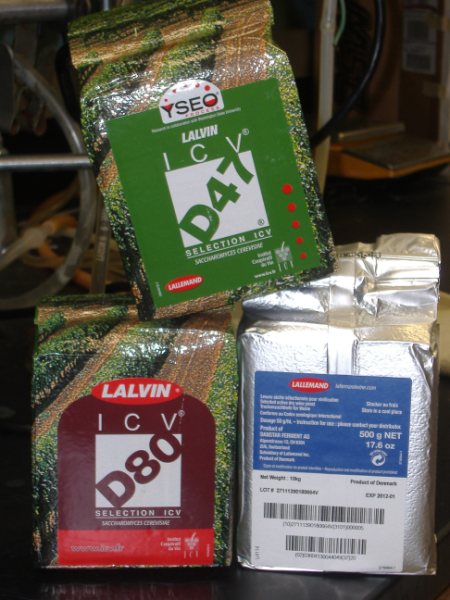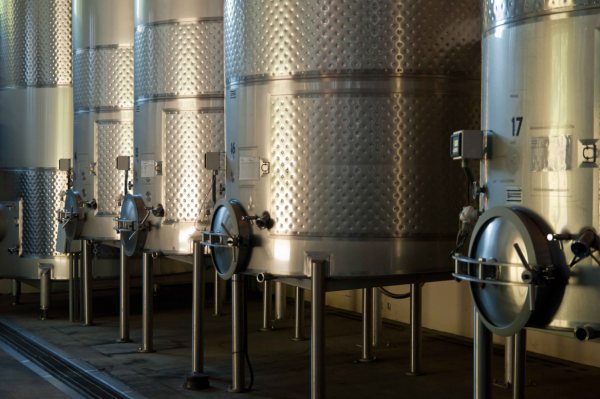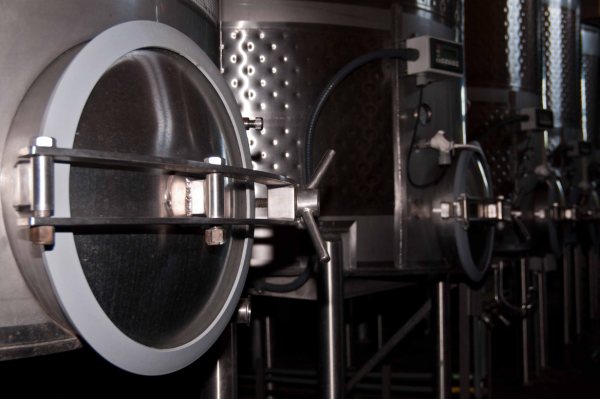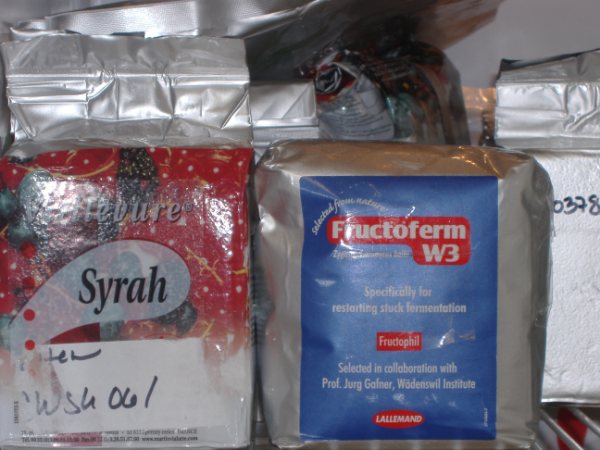Open a refrigerator in the back of many wineries and you may find some leftover pizza, cheese and fruit for tomorrow evening’s mixer, and a few rectangular foil packages that look suspiciously like the bread-baking yeast you used for pizza dough last night. Perhaps the winemaker likes to make pizza, too? Even if he does, those packages of yeast—and they are yeast—are for the wine, not bread dough. Since 1965, when Red Star introduced the first WADY (wine-active dry yeast), most winemakers have added rehydrated yeast to grape must to jump-start the magic of fermentation.
Grape must, the mixture of juice and skins that results from gentle crushing, will ferment on its own without help; or, rather, with help only from yeasts coating the grapes or found in the winery environment. Of the many different types of yeast in the world, representatives from six or seven different genera—Saccharomyces, Kloeckera, Hanseniaspora, Candida, Hansenula, Pichia, and Brettanomyces, to name a few—are often found on the same grape. Saccharomyces cerivisiae is the major player in fermenting grape juice to wine yet is, oddly, one of the least prevalent on grape skins: others usually outnumber S. cerivisiae 1,000 to 1. With a head start in terms of number, those others are enthusiastic about helping to start fermentation. However, most can’t “hold their liquor” and die off when alcohol reaches 6-8 percent. S. cerivisiae, blessed with the ability to withstand 15-18 percent alcohol, is left with less competition to grow and finish the process.
Before the advent of those foil packages, this is how wine was made. Today, most winemakers don’t let it happen that way. Instead, by inoculating with commercial yeast, native yeasts are overwhelmed and the commercial strain takes over. Realizing that S. cerivisiae will do the job in the end, commercial yeasts are almost exclusively some strain of this species.
With everything else to be done during hectic harvest season, why create the extra step—and expense—of recapitulating what will happen naturally? All yeasts are not created equal, and the commercial ones claim some useful features:
- Speed – commercial yeasts ferment faster than most wild counterparts. When longer fermentations mean higher costs, not everyone wants to afford the wait.
- High alcohol tolerance – alcohol is toxic to yeast but, like people, different strains have different tolerances. Highly tolerant strains are a must for wines reaching 13 percent or more—and better yeasts are one part reason why alcohol levels have risen. Wild yeasts may die off while fermentable sugar is left in the wine, leaving an undesirably sweet wine and a “stuck” fermentation.
- Fewer displeasing flavors – yeasts can produce odiferous compounds like urea, hydrogen sulfide, diacetyl, ethyl acetate, and phenols. Commercial yeasts tend not to make wine smell like rotten eggs or wet dog.
- Choice of pleasing flavors – since all yeasts inevitably throw off byproducts during fermentation, yeast companies sell different strains with different characteristics and flavor profiles.
- Consistency – since different yeasts contribute different flavors, using the same commercial yeast from year to year may help in creating a consistent style across vintages.
No one disagrees that these are good traits. Nonetheless, whether or not to use commercial yeast is a matter of serious debate. A vocal minority of winemakers advocate what is variably known as spontaneous, native, or natural fermentation. “Wild” or “native” yeasts may come from the grapes themselves, containers used for harvesting or transport, or air-borne droplets created when liquids are vigorously pumped or poured—no one knows—but they don’t come from a foil package.
Some of the same reasons for using commercial yeasts can be reasons for not doing so. Lower alcohol can sometimes be a good thing. Yeast byproducts can, in small amounts, add some of that hint of je ne sais quoi that makes wine fascinating. And some argue that local yeasts are part of a region’s terroir.
 Between fanatics who religiously refuse to interfere with the natural process of fermentation, and those who just as religiously inoculate there are a growing number who experiment. According to Jason Lett, winemaker at The Eyrie Vineyards in Oregon’s Willamette Valley, the trend toward native yeasts has two main motivators: the desire to make complex, unique wines, and the desire to offer a more “natural” product from vineyard to bottle.
Between fanatics who religiously refuse to interfere with the natural process of fermentation, and those who just as religiously inoculate there are a growing number who experiment. According to Jason Lett, winemaker at The Eyrie Vineyards in Oregon’s Willamette Valley, the trend toward native yeasts has two main motivators: the desire to make complex, unique wines, and the desire to offer a more “natural” product from vineyard to bottle.
For some winemakers, spontaneous fermentations are just one element in making “all natural” wine that reflects and respects the individual character of the vineyard. While still carefully controlling and overseeing fermentation, they favor cultivating and guarding desirable conditions over more active techniques. Some Italian wineries with this philosophy have formed a collective, Viniveri, by whose manifesto and regula all pledge to abide. Among other things, the regula stipulate that “only native yeasts present on the grapes or in the cellar” be used “reflects and respects the individual character of the vineyard.”
 Giampiero Bea of Paolo Bea, current president of Viniveri, likes to say, “my mission is to Produce the wine and not to Do it.” In his words, the intent of Viniveri’s rules are “to get Non Repeatable Wines Elsewhere.”
Giampiero Bea of Paolo Bea, current president of Viniveri, likes to say, “my mission is to Produce the wine and not to Do it.” In his words, the intent of Viniveri’s rules are “to get Non Repeatable Wines Elsewhere.”
“Wine should be a product of nature and not external influences intended to speed up or stabilize the winemaking process,” the regula say.
The Eyrie Vineyards has attracted attention for their non-interventionist philosophy; all of their wines spontaneously undergo malolactic fermentation, the bacteria-driven conversion of malic to lactic acid that occurs after yeast-driven alcoholic fermentation in nearly all reds and many whites. Yet even Eyrie’s winemaker, Jason Lett—inheritor of the position from his father, David Lett—inoculates some of his wines with commercial yeasts. “My Dad [David] experimented a lot back in the seventies with spontaneous fermentation…We still have those experiments around, and they’re awful.” Not willing to sacrifice the end for the means, David resorted to commercial yeast.
“All the native fermentations we experiment with now are successful,” Jason attests and, today, some Eyrie wines are spontaneously fermented. After thirty years in the business, the cellar has likely collected a healthy population of S. cerivisiae with desirable characteristics that contribute to that success. Surfaces that directly contact musts and wine are always surgery room-clean, but “the ambient ecology of the cellar is pretty laissez-faire,” and the cellar walls show it. Jason suspects, too, that larger-scale environmental changes are part of the difference between his father’s experience and his own. Far more of the valley is planted to wine grapes now than in the seventies, he notes, which may mean that more and better adapted yeasts are growing now, too. Over Eyrie’s many vintages “different grapes from different vineyards perform differently, and the yeast have something to do with that.”
 Amidst all the opinions, the consensus seems to be that spontaneous fermentation is always an experiment. Some elements do tend to increase the chance of success—a low pH grape must, dry weather during harvest, an older cellar that has had time to collect favorable yeast, for example—but the risk of sour grapes is always present at some level. Being able to absorb that risk has to be part of the decision to inoculate or not. How will the winery be affected by a vat or two or eight that spoils before it ferments or that ferments spontaneously and then tastes just plain awful? Mega-scale wineries are understandably in less of a position to experiment with 20,000 gallons of wine or so in a single fermentation tank.
Amidst all the opinions, the consensus seems to be that spontaneous fermentation is always an experiment. Some elements do tend to increase the chance of success—a low pH grape must, dry weather during harvest, an older cellar that has had time to collect favorable yeast, for example—but the risk of sour grapes is always present at some level. Being able to absorb that risk has to be part of the decision to inoculate or not. How will the winery be affected by a vat or two or eight that spoils before it ferments or that ferments spontaneously and then tastes just plain awful? Mega-scale wineries are understandably in less of a position to experiment with 20,000 gallons of wine or so in a single fermentation tank.
However, isn’t that uncertainty, that expectation of surprise, part of the attraction of wine? Some wine drinkers seem to think so. Others appreciate consistency and knowing what to expect from their favorite label. But for many, different flavors are part of what makes wine worthwhile. In the end, what matters to many wine lovers is not just what’s in the glass, but also in some part the story behind it. Wild yeasts springing up in the vineyard, dancing among the grapes, turning juice into wine with the winemaker a guardian of nature’s elemental magic, makes for a good story. When it also makes for good wine, you have the reason why ardent fans will keep the spontaneous versus inoculated debate fermenting vintage after vintage.

